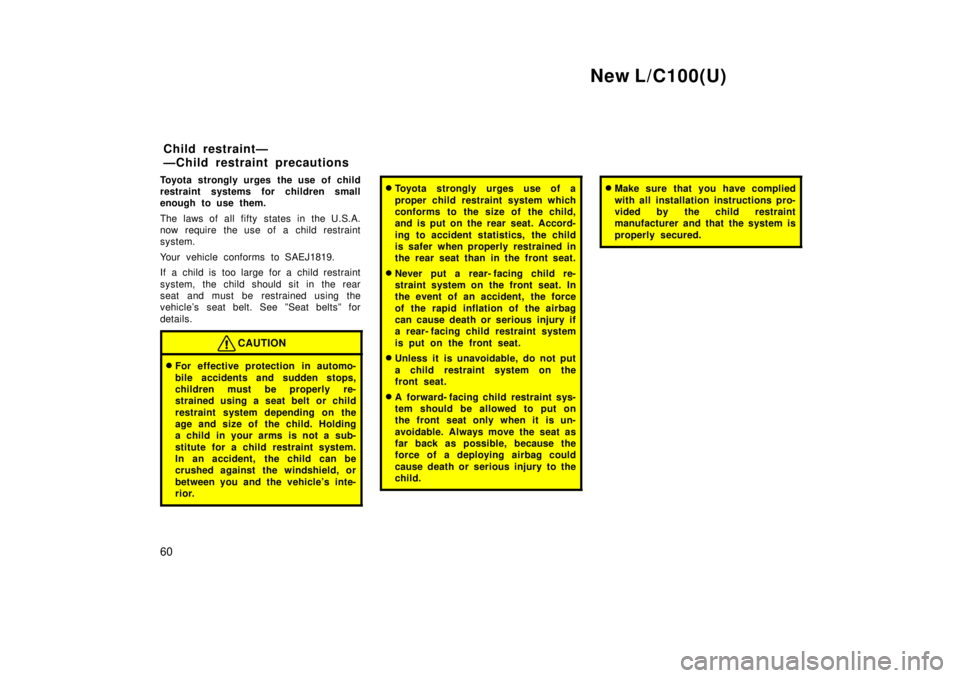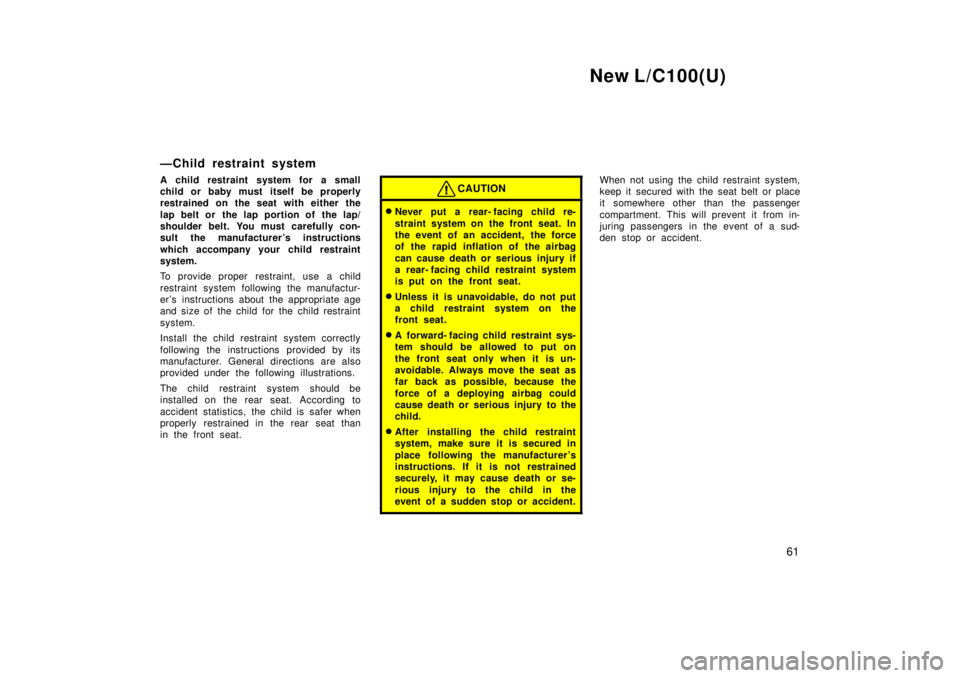Page 52 of 202

New L/C100(U)
60
Toyota strongly urges the use of child
restraint systems for children small
enough to use them.
The laws of all fifty states in the U.S.A.
now require the use of a child restraint
system.
Your vehicle conforms to SAEJ1819.
If a child is too large for a child restraint
system, the child s
hould sit in the rear
seat and must be restrained using the
vehicle's seat belt. See ºSeat beltsº for
details.
CAUTION
� For effective protection in automo-
bile accidents and sudden stops,
children must be properly re-
strained using a seat belt or child
restraint system depending on the
age and size of the child. Holding
a child in your arms is not a sub-
stitute for a child restraint system.
In an accident, the child can be
crushed against the windshield, or
between you and the vehicle's inte-
rior.
�Toyota strongly urges use of a
proper child restraint system which
conforms to the size of the child,
and is put on the rear seat. Accord-
ing to accident statistics, the child
is safer when properly restrained in
the rear seat than in the front seat.
� Never put a rear- facing child re-
straint system on the front seat. In
the event of an accident, the force
of the rapid inflation of the airbag
can cause death or serious injury if
a rear- facing child restraint system
is put on the front seat.
� Unless it is unavoidable, do not put
a child restraint system on the
front seat.
� A forward- facing child restraint sys-
tem should be allowed to put on
the front seat only when it is un-
avoidable. Always move the seat as
far back as possible, because the
force of a deploying airbag could
cause death or serious injury to the
child.�Make sure that you have complied
with all installation instructions pro-
vided by the child restraint
manufacturer and that the system is
properly secured.
Child restraintÐ
ÐChild restraint precautions
Page 53 of 202

New L/C100(U)61
ÐChild restraint system
A child restraint system for a small
child or baby must itself be properly
restrained on the seat with either the
lap belt or the lap portion of the lap/
shoulder belt. You must carefully con-
sult the manufacturer 's instructions
which accompany your child restraint
system.
To provide proper restraint, use a child
restraint system following the manufactur-
er 's instructions about the appropriate age
and size of the child for the child restraint
system.
Install the child restraint system correctly
following the instructions provided by its
manufacturer. General directions are also
provided under the following illustrations.
The child restraint system should be
installed on the rear seat. According to
accident statistics, the child is safer when
properly restrained in the rear seat than
in the front seat.
CAUTION
�
Never put a rear- facing child re-
straint system on the front seat. In
the event of an accident, the force
of the rapid inflation of the airbag
can cause death or serious injury if
a rear- facing child restraint system
is put on the front seat.
� Unless it is unavoidable, do not put
a child restraint system on the
front seat.
� A forward- facing child restraint sys-
tem should be allowed to put on
the front seat only when it is un-
avoidable. Always move the seat as
far back as possible, because the
force of a deploying airbag could
cause death or serious injury to the
child.
� After installing the child restraint
system, make sure it is secured in
place following the manufacturer 's
instructions. If it is not restrained
securely, it may cause death or se-
rious injury to the child in the
event of a sudden stop or accident.
When not using the child restraint system,
keep it secured with the seat belt or place
it somewhere other than the passenger
compartment. This will prevent it from in-
juring passengers in the event of a sud-
den stop or accident.
Page 55 of 202
New L/C100(U)63
(A) INFANT SEAT INSTALLATION
An infant seat is used in rear- facing
position only.CAUTION
Do not put a rear- facing child re-
straint system on the third seat if it
interferes with the lock mechanism of
the second seats. This may cause se-
vere injury to the child and passen-
gers sitting in the second seats in
case of sudden braking or a collision.
1. Run the center lap belt through or
around the infant seat following the
instructions provided by its manufactur-
er and insert the tab into the buckle
taking care not to twist the lap belt.
ÐInstallation with 2- point
type seat belt
Page 56 of 202
New L/C100(U)
64
CAUTION
� After inserting the tab, make sure
the tab and buckle are locked and
that the lap and shoulder portions
of the belt is not twisted.
� Do not insert coins, clips, etc. in
the buckle as this may prevent you
from properly latching the tab and
buckle.
� If the seat belt does not function
normally, it cannot protect your
child from injury. Contact your
Toyota dealer immediately. Do not
use the seat until the seat belt is
fixed.
2. While pressing the infant seat firmly
against the seat cushion and seatback,
tighten the lap belt by pulling its free
end to hold the infant seat securely.CAUTION
Push and pull the child restraint sys-
tem in different directions to be sure
it is secure. Follow all the installation
instruction provided by its manufac-
turer.
Page 58 of 202
New L/C100(U)
66
1. Run the center lap belt through or around the convertible seat following
the instructions provided by its
manufacturer and insert the tab into
the buckle taking care not to twist the
lap belt.
CAUTION
�After inserting the tab, make sure
the tab and buckle are locked and
that the lap and shoulder portions
of the belt is not twisted.
� Do not insert coins, clips, etc. in
the buckle as this may prevent you
from properly latching the tab and
buckle.
� If the seat belt does not function
normally, it cannot protect your
child from injury. Contact your
Toyota dealer immediately. Do not
use the seat until the seat belt is
fixed.
2. While pressing the convertible seat
firmly against the seat cushion and
seatback, tighten the lap belt by pulling
its free end to hold the convertible seat
securely.
Page 59 of 202
New L/C100(U)67
CAUTION
Push and pull the child restraint sys-
tem in different directions to be sure
it is secure. Follow all the installation
instructions provided by its manufac-
turer.
3. To remove the convertible seat, pressthe buckle- release button.(A) INFANT SEAT INSTALLATION
An infant seat is used in rear- facing
position only.ÐInstallation with 3- point
type seat belt
Page 60 of 202
New L/C100(U)
68
CAUTION
� Never put a rear- facing child re-
straint system on the front seat be-
cause the force of the rapid infla-
tion of the passenger airbag can
cause death or serious injury to the
child.
�Do not put a rear- facing child re-
straint system on the second (or
third) seat if it interferes with the
lock mechanism of the front (or se-
cond) seats. This may cause severe
injury to the child and front passen-
ger in case of sudden braking or a
collision.1. Run the lap and shoulder belt through
or around the infant seat following the
instructions provided by its manufactur-
er and insert the tab into the buckle
taking care not to twist the belt. Keep
the lap portion of the belt tight.
Page 61 of 202
New L/C100(U)69
CAUTION
�After inserting the tab, make sure
the tab and buckle are locked and
that the lap and shoulder portions
of the belt are not twisted.
� Do not insert coins, clips, etc. in
the buckle as this may prevent you
from properly latching the tab and
buckle.
� If the seat belt does not function
normally, it cannot protect your
child from injury. Contact your
Toyota dealer immediately. Do not
use the seat until the seat belt is
fixed.
2. Fully extend the shoulder belt to put it
in the lock mode. When the belt is
then retracted even slightly, it cannot
be extended.
To hold the infant seat securely, make
sure the belt is in the lock mode before
letting the belt retract.3. While pressing the infant seat firmly against the seat cushion and seatback,
let the shoulder belt retract as far as
it will go to hold the infant seat secure-
ly.